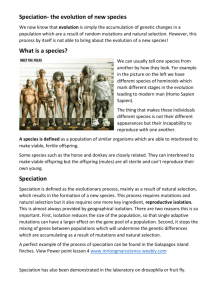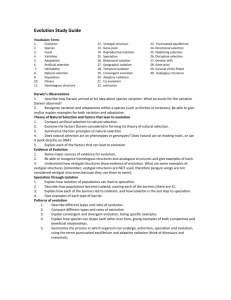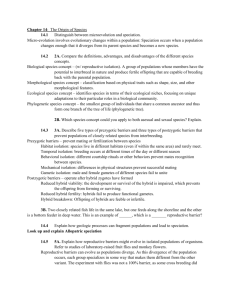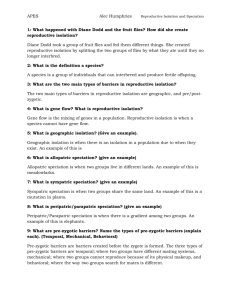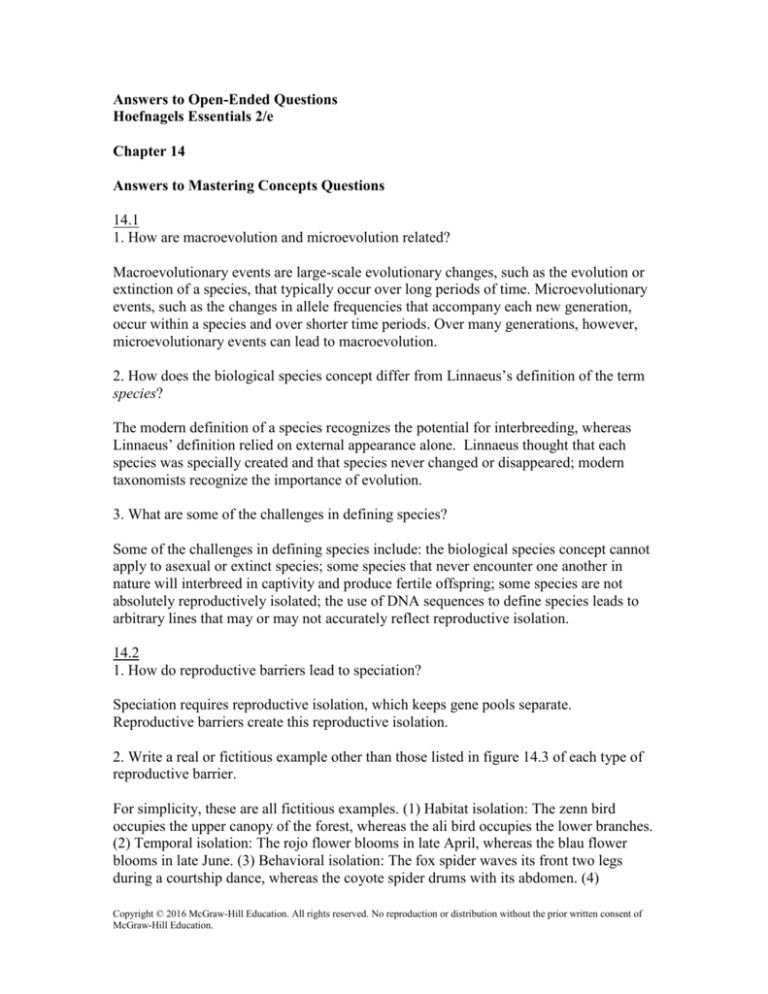
Answers to Open-Ended Questions
Hoefnagels Essentials 2/e
Chapter 14
Answers to Mastering Concepts Questions
14.1
1. How are macroevolution and microevolution related?
Macroevolutionary events are large-scale evolutionary changes, such as the evolution or
extinction of a species, that typically occur over long periods of time. Microevolutionary
events, such as the changes in allele frequencies that accompany each new generation,
occur within a species and over shorter time periods. Over many generations, however,
microevolutionary events can lead to macroevolution.
2. How does the biological species concept differ from Linnaeus’s definition of the term
species?
The modern definition of a species recognizes the potential for interbreeding, whereas
Linnaeus’ definition relied on external appearance alone. Linnaeus thought that each
species was specially created and that species never changed or disappeared; modern
taxonomists recognize the importance of evolution.
3. What are some of the challenges in defining species?
Some of the challenges in defining species include: the biological species concept cannot
apply to asexual or extinct species; some species that never encounter one another in
nature will interbreed in captivity and produce fertile offspring; some species are not
absolutely reproductively isolated; the use of DNA sequences to define species leads to
arbitrary lines that may or may not accurately reflect reproductive isolation.
14.2
1. How do reproductive barriers lead to speciation?
Speciation requires reproductive isolation, which keeps gene pools separate.
Reproductive barriers create this reproductive isolation.
2. Write a real or fictitious example other than those listed in figure 14.3 of each type of
reproductive barrier.
For simplicity, these are all fictitious examples. (1) Habitat isolation: The zenn bird
occupies the upper canopy of the forest, whereas the ali bird occupies the lower branches.
(2) Temporal isolation: The rojo flower blooms in late April, whereas the blau flower
blooms in late June. (3) Behavioral isolation: The fox spider waves its front two legs
during a courtship dance, whereas the coyote spider drums with its abdomen. (4)
Copyright © 2016 McGraw-Hill Education. All rights reserved. No reproduction or distribution without the prior written consent of
McGraw-Hill Education.
Mechanical isolation: The square fish has reproductive parts that do not fit with the circle
fish’s reproductive parts. (5) Gametic isolation: The marrone tree has pollen that cannot
fertilize the egg of the laranja tree. (6) Hybrid inviability: The rubber mushroom and the
paper mushroom unite to form the first cells of the bundle mushroom, but the hybrid cells
fail to divide more than a few times. (7) Hybrid infertility: The donut beetle and the
burger beetle produce a viable, donutburger offspring that is unable to produce gametes
(it is sterile). (8) Hybrid breakdown: The bumpy toad and the lumpy toad produce viable,
fertile, hybrid offspring called dumpy toads. The offspring of the hybrids, however, have
reduced fitness.
14.3
1. Distinguish among allopatric and sympatric speciation, and provide examples of each.
In allopatric speciation, a geographic barrier separates two populations. One example is
the dry land that separates the pools where different species of desert pupfish live.
Sympatric speciation occurs within the overlapping ranges of two species. For example,
new polyploid plant species can arise from, and be reproductively isolated from, their
diploid ancestors.
2. How can polyploidy contribute to sympatric speciation?
Polyploidy results in plants with extra sets of chromosomes. Sympatric speciation occurs
if plants with extra chromosomes cannot interbreed with the original plant population,
even if the plants share the same habitat.
3. Why is it sometimes difficult to determine whether speciation is allopatric or
sympatric?
The difficulty arises from several factors. First, the two patterns represent points along a
continuum, from total isolation to continuous intermingling. Second, it is often difficult
to recognize what constitutes a reproductive barrier to a species. Finally, the size of the
barrier needed varies with the range over which the gametes spread.
14.4
1. Describe the theories of gradualism and punctuated equilibrium.
Gradualism proposes that the rate of evolutionary change is slow and steady, with many
intermediate forms. Punctuated equilibrium proposes that evolutionary change occurs in
discontinuous, fast bursts that interrupt long periods in which a species does not change.
2. How can the fossil record support both gradualism and punctuated equilibrium?
The fossil record can support both models because of the great variety in species and
habitats worldwide, and because the pace of environmental change varies over time.
14.5
Copyright © 2016 McGraw-Hill Education. All rights reserved. No reproduction or distribution without the prior written consent of
McGraw-Hill Education.
1. What factors can cause or hasten extinction?
Factors that can hasten extinction include habitat loss, the introduction of new diseases or
new predators, rapid environmental change, and small population size (which is
associated with low genetic diversity).
2. Distinguish between background and mass extinctions.
Background extinctions continually occur at a steady rate of 0.1 to 1.0 species per year
per million species. Mass extinctions occur only rarely and kill off many species over a
short period of time.
3. How have humans influenced extinctions?
Humans have influenced extinctions by destroying and polluting habitats, introducing
alien species that compete with native species, and harvesting species faster than they can
reproduce.
14.6
1. Describe the taxonomic hierarchy.
The taxonomic hierarchy consists of nested groups based on similarities from the level of
the species (the least inclusive category) up to the three domains (the most inclusive
category). The order of the hierarchy is domain, kingdom, phylum, class, order, family,
genus, species.
2. What is the advantage of a cladistics approach over a more traditional approach to
phylogeny?
A traditional approach to taxonomy may be based on superficial similarities that do not
reflect evolutionary relationships. Cladistics generates phylogenetic trees based on
common ancestry and shared derived characters.
3. Distinguish between ancestral and derived characters.
An ancestral character is one that was present in the last common ancestor, and a derived
character arose after the taxon split off from the ancestral group.
Write It Out
1. How has the meaning of the term species changed since the time of Linnaeus?
Linnaeus devised a system of binomial nomenclature based on specific physical
characteristics. The current system uses physical, biochemical, and genetic information
along with common ancestry to define a species.
Copyright © 2016 McGraw-Hill Education. All rights reserved. No reproduction or distribution without the prior written consent of
McGraw-Hill Education.
2. What type of reproductive barrier applies to each of these scenarios?
a. Humans introduced apple trees to North America in the 1800s. Insects called hawthorn
flies, which feed and mate on hawthorn plants, quickly discovered the new fruits. Some
flies preferred the taste of apples to their native host plants. Because these flies mate
where they eat, this difference in food preference quickly led to a reproductive barrier.
b. Water buffalo and cattle can mate, but the embryos die early in development.
c. Scientists try to mate two species of dragonfly that inhabit the same pond at the same
time of day. However, females never allow males of the other species to mate with them.
d. One species of reed warbler is active in the upper parts of the tree canopy while
another species of reed warbler is active in the lower canopy. Both species are active
during the day.
e. Scientists mate two parrots from different populations to see if speciation has occurred.
The parrots mate over and over again, but the male’s sperm never fertilizes the female’s
egg.
a) Habitat isolation b) Hybrid inviability c) Behavioral isolation d) Habitat isolation e)
Mechanical isolation
3. If the apple-feeding flies from question 2a form a different species from their
hawthorn-feeding relatives, which type of speciation has occurred?
Sympatric speciation will have occurred because the apple and hawthorn trees are in the
same location; the flies can still move between apple trees and hawthorn trees.
4. Scientists have found a group of finches on the Galápagos Islands that sing a slight
variation of a normal finch song. The finches with the off-tune song arose only a few
generations ago and mate only among one another. Should these finches be classified as
distinct species from the other finches on the island? Explain your answer.
It appears that the new song has formed a reproductive barrier (behavioral isolation)
between the new group of finches and the ancestral finches. These two groups could be
considered distinct species under the biological species concept.
5. Polyploidy is a common mechanism of speciation in plants. When the chromosome
number of a plant doubles, the offspring may not be able to breed with the parent plant.
Alternatively, gametes of related species may fuse, producing polyploid offspring unable
to reproduce with either parent. How are these two mechanisms of speciation similar?
How might you draw each speciation event on an evolutionary tree?
In both cases, polyploidy produces individuals that cannot breed with parent plants but
can breed among each other. The polyploid offspring therefore form a distinct species. If
polyploidy arose as a result of a chromosome-doubling event in the parent plant, then on
the evolutionary tree you would draw a line coming off the parent lineage, indicating the
formation of a new species. However, if polyploidy arose as a result of unrelated species
Copyright © 2016 McGraw-Hill Education. All rights reserved. No reproduction or distribution without the prior written consent of
McGraw-Hill Education.
combining gametes, then you might draw lines coming off each parent plant’s lineage
and uniting to form the new species lineage.
6. How does natural selection predict a gradualistic mode of evolution? Does the
presence of fossils that are consistent with punctuated equilibrium mean that natural
selection does not occur?
Natural selection predicts gradual changes within a species, based upon unequal
reproductive success in a changing environment. Punctuated equilibrium does not counter
the concept of natural selection; it just means that natural selection occurs more rapidly at
some times than at others.
7. Why do species become extinct? Choose a species that has recently become extinct
and describe some possible evolutionary consequences to other species that interacted
with that species before its extinction.
Species can become extinct when too few individuals have adaptations that enable them
to survive and reproduce in a changing environment. (Species choices and consequences
will vary.)
8. What information would you need to determine the background extinction rate
hundreds of millions of years ago? How might you determine the current extinction rate?
The rate at which species disappear from the fossil record would indicate the background
extinction rate hundreds of millions of years ago (for organisms that fossilize easily). To
determine the extinction rate today, scientists have to learn how many species currently
exist, conduct population counts, determine the forces that cause extinction, and measure
the rate at which those forces occur for each species.
9. Examine the cladogram in figure 14.17 and answer the following questions:
a. Which taxon is most closely related to birds?
b. Are lizards more closely related to crocodiles or turtles?
c. Which taxon is ancestral to all the others?
d. Redraw the tree so that birds are next to mammals without changing the evolutionary
relationships among any of the taxa.
(a) Nonavian dinosaurs are most closely related to birds. (b) Lizards are more closely
related to crocodiles than they are to turtles. (c) Amphibians are ancestral to all other taxa
in the cladogram. (d) Answer will be visual. Rotate the clade including birds, nonavian
dinosaurs, crocodiles, lizards, and turtles around the common ancestor of these five taxa.
Rotating the lineages around this point does not change the evolutionary relationships
among the groups. From top to bottom, the taxa along the right side of the evolutionary
tree will be turtles, lizards/snakes, crocodiles, nonavian dinosaurs, birds, mammals, and
amphibians.
Copyright © 2016 McGraw-Hill Education. All rights reserved. No reproduction or distribution without the prior written consent of
McGraw-Hill Education.
10. Figure 16.3 summarizes the hypothesized evolutionary relationships among living
plants. Do the gymnosperms form a clade? Explain your answer.
Yes. According to figure 16.3, the gymnosperms form a clade because the four taxa of
gymnosperms (gnetophytes, conifers, ginkgos, and cycads) are the only lineages derived
from a common ancestor.
11. Figure 17.3 shows a phylogenetic tree for animals. How many clades are depicted in
the figure?
The total number of clades is 17, derived as follows: (1) the whole tree; (2) the sponges;
(3) the true tissues clade; (4) the radial symmetry clade; (5) the bilateral symmetry clade;
(6) the protostome clade; (7) the lophotrochozoan clade; (8) the flatworms; (9) the
annelid/mollusk clade; (10) the annelids; (11) the mollusks; (12) the ecdysozoan clade;
(13) the arthropods; (14) the roundworms; (15) the deuterostomes; (16) the chordates;
(17) the echinoderms.
Answers to Pull It Together Questions
1. How do reproductive barriers relate to the biological species concept?
Reproductive barriers separate gene pools within a population. If two genetic lines
remain isolated for generations, differences will arise. A species, therefore, forms when
part of a population cannot breed with the rest of the population.
2. Add fertilization and offspring to the concept map.
“Prezygotic” could connect with the phrase “barriers prevent” to “Fertilization.”
“Postzygotic” could connect with the phrase “barriers prevent the production of fertile” to
“Offspring.”
3. Add gradualism and punctuated equilibrium to this concept map.
“Speciation” could connect with the phrase “occurring in small steps is called” to
“Gradualism”. “Speciation” could connect with the phrase “occurring in bursts is called”
to “Punctuated equilibrium.”
4. How do species become extinct?
A species becomes extinct when its individuals die faster than they reproduce. Forces that
drive species extinct include overhunting, habitat destruction, predation, disease, and
catastrophes.
Copyright © 2016 McGraw-Hill Education. All rights reserved. No reproduction or distribution without the prior written consent of
McGraw-Hill Education.





